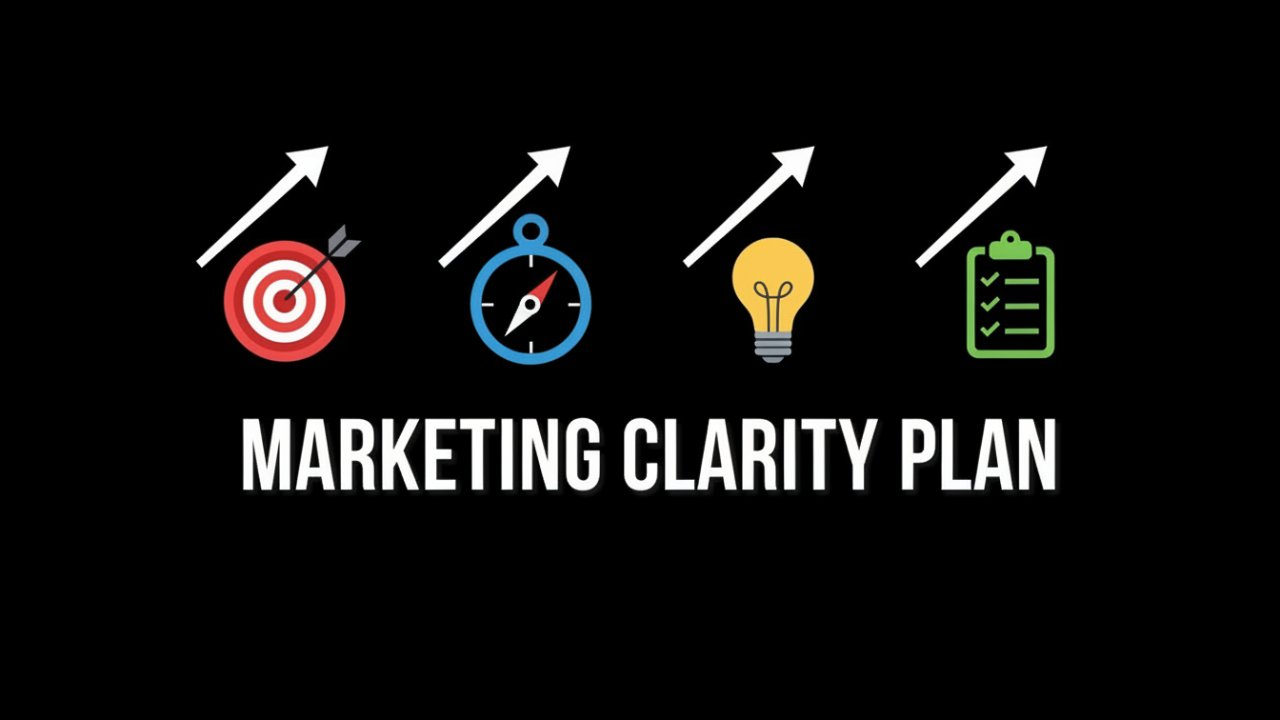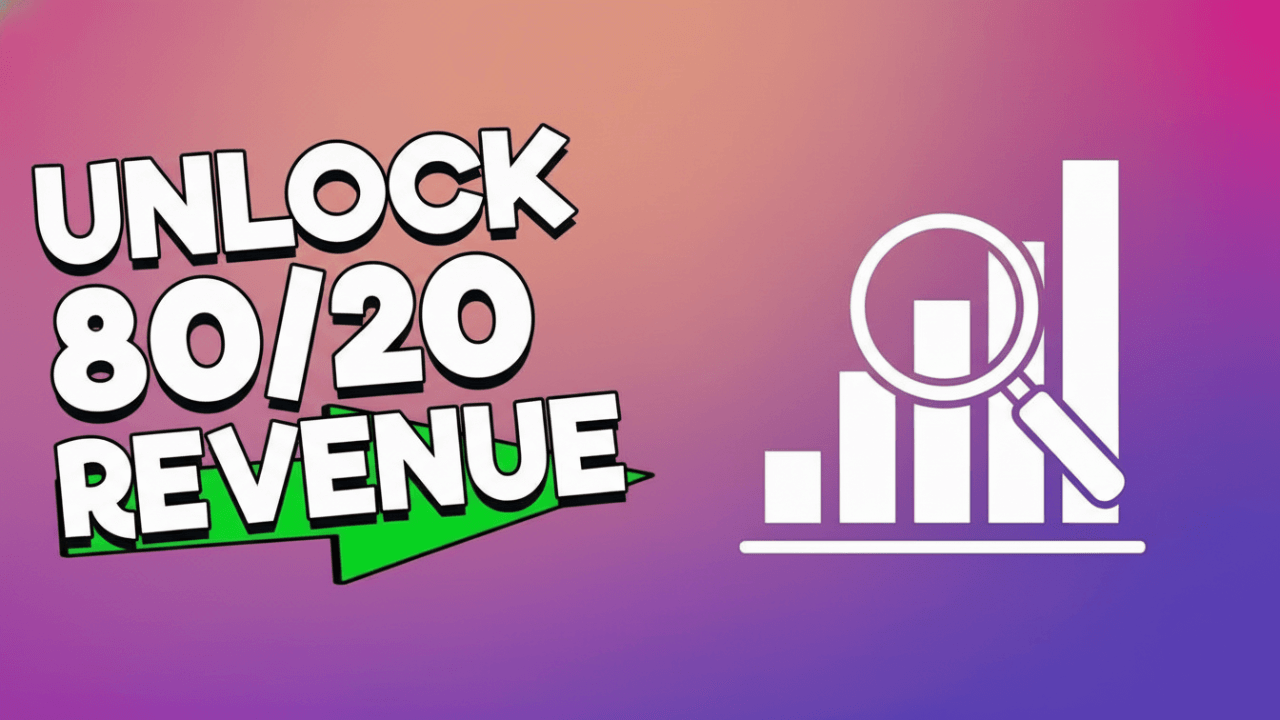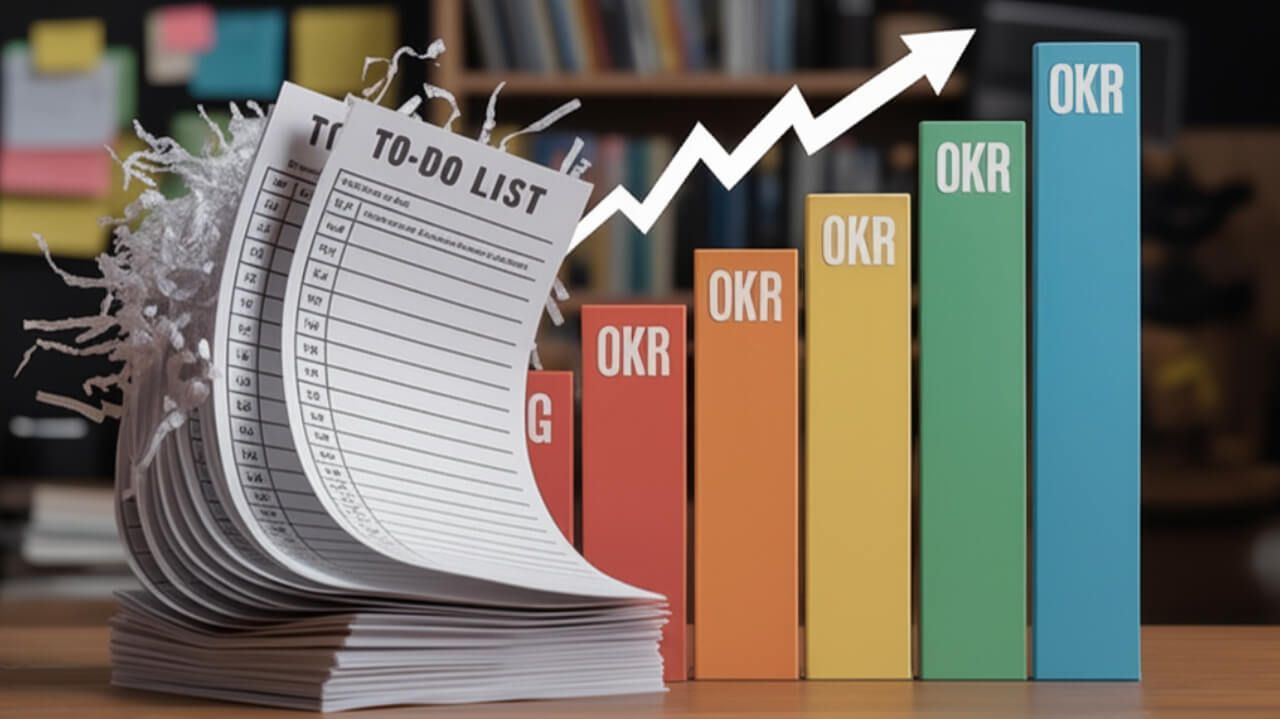How to Turn a Vague Goal into a 5-Step Action Plan Using OKRs
That Big Idea on a Napkin? Here’s How to Actually Make It Happen
We’ve all been there. You’re sitting in your favourite local coffee shop, the ideas are flowing, and you grab a napkin. On it, you scribble the big one, the game changer for your business: “Grow the brand” or “Finally sort out marketing” or the classic, “Make more money.” It feels brilliant, full of potential. You tuck it into your pocket, feeling inspired.
A week later, you find that napkin in your jeans pocket before putting them in the wash. The big idea is still there, but now it just looks… vague. Overwhelming, even. Where on earth do you start with something like “Grow the brand”? It’s so big and blurry that you end up doing nothing, or you do a little bit of everything, flitting between posting on Instagram, tinkering with your website, and then getting bogged down in emails. The momentum is gone.
If that sounds even vaguely familiar, you’re not alone. I think it’s one of the biggest, quietest struggles for small business owners in the UK. We are fantastic at the big picture vision but can get stuck in the fog between the idea and the action. The secret isn’t working harder. It’s about getting smarter with how you plan.
This is where a simple but incredibly powerful framework called OKRs, or Objectives and Key Results, comes in. Don’t let the acronym scare you. It’s not just for Silicon Valley tech giants. It’s a practical tool that anyone can use to turn those fuzzy, napkin-sized dreams into a concrete, step by step action plan. I’m going to walk you through exactly how to do it, in five clear steps
Why Your Vague Goals Are Quietly Sabotaging You
Before we jump into the solution, let’s be honest about the problem. A goal like “increase sales” isn’t really a goal. It’s a wish. And wishes don’t pay the bills.
Vague goals create a few massive problems. First, there’s no clarity. Your brain doesn’t know what to do with it. If I tell you to “drive north,” you could end up anywhere. If I tell you to “drive to the Peak District and park at the Mam Tor car park,” you know exactly what to do. Your business goals need that same level of GPS accuracy. Without it, your team, if you have one, is just as lost as you are.
Second, you can’t measure them. How do you know when you’ve successfully “improved customer happiness”? When one person sends a nice email? When you get a five-star review? Without a number to aim for, you never get that satisfying feeling of achievement, that dopamine hit that tells you you’re on the right track. This leads directly to the third problem: a total lack of motivation. Big, fuzzy goals are exhausting. They feel like trying to push a boulder up a hill with no end in sight. The natural human response to that is procrastination. We’ll answer a few more emails or tidy the stockroom instead, because those are tasks we know how to complete. This scattered effort means you’re busy, for sure, but are you actually moving the business forward? Maybe not.
Transforming those wishes into specific, measurable goals gives you a roadmap. It tells you what to do on a rainy Tuesday morning and helps you say no to the distracting ‘opportunities’ that pop up. It gives you control.
Step 1: First, Get Brutally Honest and Clarify Your Goal
Right, let’s get practical. The first step is to take your big, vague goal and pin it down. Most of us have a dozen things we want to achieve, but the key to making real progress is to focus on the one thing that will make the biggest difference right now, or at least over the next three months.
I want you to ask yourself a couple of tough questions. Sit down with a proper cup of tea, not just a rushed one at your desk, and really think about it.
- What is the single most important outcome I want to see in my business this quarter?
- If I could only move the needle on one thing, what would create the most positive ripple effect across everything else?
- What does success here actually look like? Paint a picture.
Let’s say your vague goal is “Get more customers.” That could mean anything. Let’s clarify it. Maybe what you really mean is you want to stop relying on word of mouth from the same five loyal clients. So, the clarified goal might be, “Establish a reliable system for generating new leads online.” See the difference? It’s already more focused.
Here are a few more examples:
- Vague: “Do better on social media.”
- Clarified: “Use Instagram to drive traffic to my online shop and build a community of local followers.”
- Vague: “Improve our finances.”
- Clarified: “Increase our profit margin so we have healthier cash flow.”
Don’t move on to the next step until you have a single, clear sentence that feels right. This is your North Star for the next 90 days.
Step 2: Make Your Goal Specific with OKRs
Now we bring in the magic of OKRs. This is the framework that will add the muscle to your clarified goal. It’s beautifully simple.
An OKR has two parts:
- Objective (O): This is your clarified goal, but phrased in an inspiring, qualitative way. It’s the ‘what’. It should feel ambitious and maybe a little bit exciting.
- Key Results (KRs): These are the measurable outcomes that prove you’ve achieved your objective. There are usually 3 to 5 of them. They are the ‘how you’ll know’. They must have numbers.
Let’s use our example from before.
Objective: Establish our business as the go to expert in our niche within our local county.
That’s a great objective. It’s inspiring. But how would we know if we’ve actually done it? This is where the Key Results come in. They take the ambiguity out.
- Key Result 1: Increase organic website traffic from within our county by 40%.
- Key Result 2: Secure a feature or interview in two major local publications or podcasts.
- Key Result 3: Get 25 new five star Google reviews from local customers.
Suddenly, our inspiring idea has teeth. We know exactly what we are aiming for. Each Key Result is specific, measurable, and time bound (we’re aiming to do this in one quarter). If you’ve ever heard of SMART goals (Specific, Measurable, Achievable, Relevant, Time bound), you’ll see that your Key Results should always be SMART. They are the evidence. At the end of the quarter, you can look at these and say, “Did we do it?” There’s no grey area.
Step 3: Now, Break It Down into Actionable Steps
Okay, so you have your Objective and your Key Results. You know where you’re going and you know what the milestones look like. But you still need to know what to do on a daily or weekly basis. This is where you break everything down into tiny, manageable tasks.
This step is crucial because it defeats procrastination. You’re no longer faced with the scary KR of “Increase website traffic by 40%.” Instead, you’re looking at a list of simple to do items.
Let’s break down one of our Key Results from above:
Key Result 1: Increase organic website traffic from within our county by 40%.
What actual work would lead to that result?
- Tasks:
- Research and identify 10 keywords that local people search for (e.g., “artisan bakery in Cheshire”).
- Write and publish four new blog posts, each one targeting one of those keywords.
- Fully optimise our Google Business Profile with new photos, posts, and services.
- Reach out to three other local, non competing businesses for a potential backlink swap.
- Perform a basic SEO audit on our top 5 website pages to improve their titles and descriptions.
Each of these is a concrete task you can put in your diary. “Write one blog post” is so much less intimidating than the big, hairy goal it serves. The trick is to make each task small enough that you can’t really make an excuse not to do it. Think in terms of tasks that take between 30 minutes and a couple of hours, not tasks that take days.
Step 4: Give It a Deadline and Resources
An idea without a deadline is just a dream. This is the step where your plan becomes real, where it moves from a document into your calendar. You need to assign deadlines to your tasks and figure out what resources you need.
For each task you listed in Step 3, you need to decide two things:
- When will it be done? Be realistic. Don’t just say “by the end of the month.” Block out actual time in your calendar. For example, “Friday, 10am to 12pm: Write blog post on local suppliers.” This creates accountability. You’re making an appointment with your own progress.
- What do I need to do it? Resources aren’t just about money, although that can be part of it (“I’ll allocate a £50 budget for a targeted Facebook ad”). It’s also about time, skills, and people. Do you need to set aside four hours of uninterrupted time? Do you need to ask your part time assistant to handle customer emails while you focus on this? Do you need to watch a quick YouTube tutorial to learn how to do something?
For tools, please, keep it simple. You don’t need a fancy, expensive project management system. A free tool like Trello or Asana is fantastic for this. You can create a board for your Objective, lists for your Key Results, and cards for each task. A simple Google Sheet or even a physical wall planner can work just as well. The best tool is the one you will actually use.
Step 5: Check In, Track, and Be Ready to Pivot
Finally, your plan is not a sacred document that must be followed to the letter. It’s a living map. Business is dynamic, and you need to be too. This final step is about monitoring your progress and being smart enough to adjust when needed.
Set up a regular, non-negotiable time to review your progress. For a small business owner, I think a quick 20-minute check in every Friday afternoon is perfect. Look at your OKRs and ask:
- How are we tracking against our Key Results? You can measure this as a percentage of completion. For example, “We’ve increased local traffic by 10%, so we are 25% of the way to our goal of 40%.”
- What’s working? What’s not?
- Do we need to change our approach?
This last question is so important. Maybe you discover that writing blog posts is taking forever and not bringing in much traffic, but your optimised Google Business Profile is flying. Great! That’s not a failure, that’s valuable data. You can now decide to double down on your Google profile and ease off on the blogging for a bit. This is the difference between being busy and being effective. You’re making decisions based on real results, not just ploughing ahead with a plan that isn’t working.
This regular review cycle also does wonders for your motivation. Seeing those percentages creep up week by week is incredibly rewarding and keeps the momentum going.
A Quick Example: Sarah’s Bookshop
Let’s put it all together. Meet Sarah, who runs an independent bookshop.
- Vague Goal: “I want to sell more books.”
- Step 1 (Clarify): “I want to become the community hub for local book lovers, not just a place that sells books.”
- Step 2 (OKRs):
- Objective: Create a thriving community around the bookshop this quarter.
- KR1: Host 3 author events with an average of 25 attendees each.
- KR2: Grow our events email list from 150 to 400 subscribers.
- KR3: Launch a book club that retains 10+ active members by the end of the quarter.
- Step 3 (Actions for KR1): Research local authors, create an event proposal template, design a poster, promote on local Facebook groups, set up online ticketing.
- Step 4 (Deadlines & Resources): Contact 5 authors by Friday. Dedicate Monday mornings to event planning. Budget £100 for social media promotion.
- Step 5 (Monitor): Every Friday, Sarah checks ticket sales, email sign ups, and book club applications. After the first event, she sends a feedback form to attendees to make the next one even better.
See how that journey takes her from a fuzzy wish to a clear, confident action plan? She knows exactly what she needs to do each week to make her vision a reality.
A Few Final Tips
- Embrace flexibility. Your quarterly plan is a guide, not a straitjacket. A new opportunity might arise that’s better than your original plan. That’s okay.
- Celebrate the small wins. Did you finish that blog post? Get your first new Google review? Acknowledge it. Small business life can be a grind, and these little moments of celebration are the fuel that keeps you going.
- Find an accountability partner. This could be another business owner, a friend, or a coach like our very own Adam Payne. Just having to say your goals out loud to someone else makes them infinitely more real.
Turning your big, ambitious goals into a clear plan isn’t about adding more bureaucracy to your life. It’s about removing the friction and the guesswork. It’s about giving your brilliant ideas the structure they need to actually come to life.
So, what’s the one vague goal that’s been floating around in the back of your mind? Take it out. Right now. Spend ten minutes just working through Step 1. Clarify what you really mean. You might be surprised at how much progress you can make when you finally know exactly where you’re going.
If you’ve read this and feel that spark of clarity but would like a hand in building your own bespoke action plan, that’s exactly what we do. Our Small Business Growth Coaching sessions are designed to help you cut through the noise, set powerful OKRs, and build the momentum you need. Let’s turn that napkin idea into your next big success story.
Take the first step toward clarity today. Your future self will thank you for it.
[Discover our 1-Hour Business Growth Coaching Session]
Additional Resources:
For further material on related topics, consider exploring the following:
Ready to Turn Information into Action?
Reading about solutions is one thing, but implementing them when you're already overwhelmed is another. If you're ready to stop spinning your wheels and get a clear, actionable plan, it's time to talk to someone who's been in the trenches.
Adam isn't just a coach; he's a fellow business builder who can help you find the clarity you need in a single hour. Book a no-obligation, honest conversation with Adam at New Way Growth. No sales pitches, just a genuine chat about your goals and the obstacles holding you back.
Reclaim your momentum, energy, and confidence.
Contact us now and let’s turn your business strategy into unstoppable progress.
Phone: 0330 311 2820
We look forward to helping you discover your unique path to growth, strategies that fit you - not the other way round.
Pay It Forward! Sharing Is Caring!











